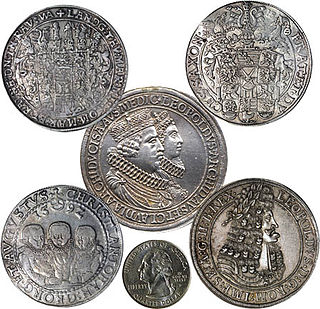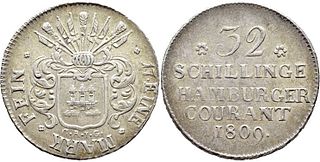
A thaler or taler is one of the large silver coins minted in the states and territories of the Holy Roman Empire and the Habsburg monarchy during the Early Modern period. A thaler size silver coin has a diameter of about 40 mm and a weight of about 25 to 30 grams. The word is shortened from Joachimsthaler, the original thaler coin minted in Joachimsthal, Bohemia, from 1520.

The German mark was the currency of the German Empire, which spanned from 1871 to 1918. The mark was paired with the minor unit of the pfennig (₰); 100 pfennigs were equivalent to 1 mark. The mark was on the gold standard from 1871 to 1914, but like most nations during World War I, the German Empire removed the gold backing in August 1914, and gold coins ceased to circulate.

The Vereinsthaler was a standard silver coin used in most German states and the Austrian Empire in the years before German unification.
The Silbergroschen was a coin used in Prussia and several other German Confederation states in northern Germany during the 19th century, worth one thirtieth of a Thaler.

The Austro-Hungarian gulden was the currency of the lands of the House of Habsburg between 1754 and 1892, when it was replaced by the Austro-Hungarian krone as part of the introduction of the gold standard. In Austria, the gulden was initially divided into 60 kreuzers. The currency was decimalized in 1857, using the same names for the unit and subunit.
The South German Gulden was the currency of the states of Southern Germany between 1754 and 1873. These states included Bavaria, Baden, Württemberg, Frankfurt and Hohenzollern. It was divided into 60 kreuzer, with each kreuzer worth 4 pfennig or 8 heller.

The Hamburg Mark refers to two distinct currencies issued in the city of Hamburg until 1875:
The Prussian Thaler was the currency of Prussia until 1857. In 1750, Johann Philipp Graumann implemented the Graumannscher Fuß with 14 thalers issued to a Cologne Mark of fine silver, or 16.704 g per thaler.
The Vereinsthaler was the currency of Prussia between 1857 and 1873. It replaced the Thaler at par and was replaced by the Mark at a rate of 1 Vereinsthaler = 3 Mark. The Vereinsthaler was subdivided into 30 Silbergroschen, each of 12 Pfennings.
The North German thaler was the currency of the Electorate and Kingdom of Saxony until 1857. Between 1754 and 1841, it was equal to three quarters of a Conventionsthaler and was subdivided into 24 Groschen, each of 12 Pfennig. In 1841, Saxony partially decimalized, dividing the Thaler into 30 Neugroschen, each of 10 Pfennig. The Thaler was replaced by the Vereinsthaler at par.
The Vereinsthaler was the currency of the Kingdom of Hanover between 1857 and 1866. The Vereinsthaler replaced the prior Thaler at par. The Vereinsthaler was first subdivided into 24 Groschen, each of 12 Pfennig, thus 288 Pfennig = 1 Vereinsthaler. From 1858 on the subdivisions were more decimalised to 30 Groschen, each of 10 Pfennig, thus 300 Pfennig making up a Vereinsthaler.
The Thaler was the currency of the Electorate, later Kingdom of Hanover until 1857. It was identical to the North German thaler except from 1754 to 1834 when it was worth 1/12 a Cologne Mark of fine silver. It was subdivided into 36 Mariengroschen, each of 8 Pfennig.
The Vereinsthaler was the currency of the two Grand Duchies of Mecklenburg-Schwerin and Mecklenburg-Strelitz between 1857 and 1873. It replaced the Mecklenburg Thaler at par and was replaced by the Mark at a rate of 1 Vereinsthaler = 3 Mark. The Vereinsthaler was subdivided into 48 Schillinge, each of 12 Pfenninge.
The Thaler was the currency of the two Duchies, later Grand Duchies, of Mecklenburg-Schwerin and Mecklenburg-Strelitz until 1857. It was replaced the Mecklenburg Vereinsthaler at par. From the 1750s it was identical to the Hanoverian thaler at 1/12 a Cologne Mark of fine silver. From 1848, it was equal to the Prussian Thaler at 1/14 a Mark.
The Vereinsthaler was the currency of the Electorate of Hesse-Kassel between 1858 and 1873. It replaced the Thaler at par and was replaced by the German Mark at a rate of 1 Vereinsthaler = 3 Mark.
The North German thaler was the currency of the Landgravate, then Electorate of Hesse-Kassel until 1858. Until 1807, the Thaler was subdivided into 32 Albus, each of 12 Heller. It was worth 3⁄4th a Conventionsthaler from 1754 to 1841.

Bavaria used the South German gulden as its currency until 1873. Between 1754 and 1837 it was a unit of account, worth 5⁄12 of a Conventionsthaler, used to denominate banknotes but not issued as a coin. The Gulden was worth 50 Conventionskreuzer or 60 Kreuzer Landmünze.

Baden used the South German gulden as its currency from 1754 until 1873. Until 1821, the Gulden was a unit of account, worth 5⁄12 of a Conventionsthaler, used to denominate banknotes but not issued as a coin. It was subdivided into 50 Conventionskreuzer or 60 Kreuzer landmünze.
Events from the year 1873 in Germany.
The North German thaler was a currency used by several states of Northern Germany from 1690 to 1873, first under the Holy Roman Empire, then by the German Confederation. Originally equal to the Reichsthaler specie or silver coin from 1566 until the Kipper und Wipper crisis of 1618, a thaler currency unit worth less than the Reichsthaler specie was first defined in 1667 and became widely used after adoption of the Leipzig currency standard of 1690.






